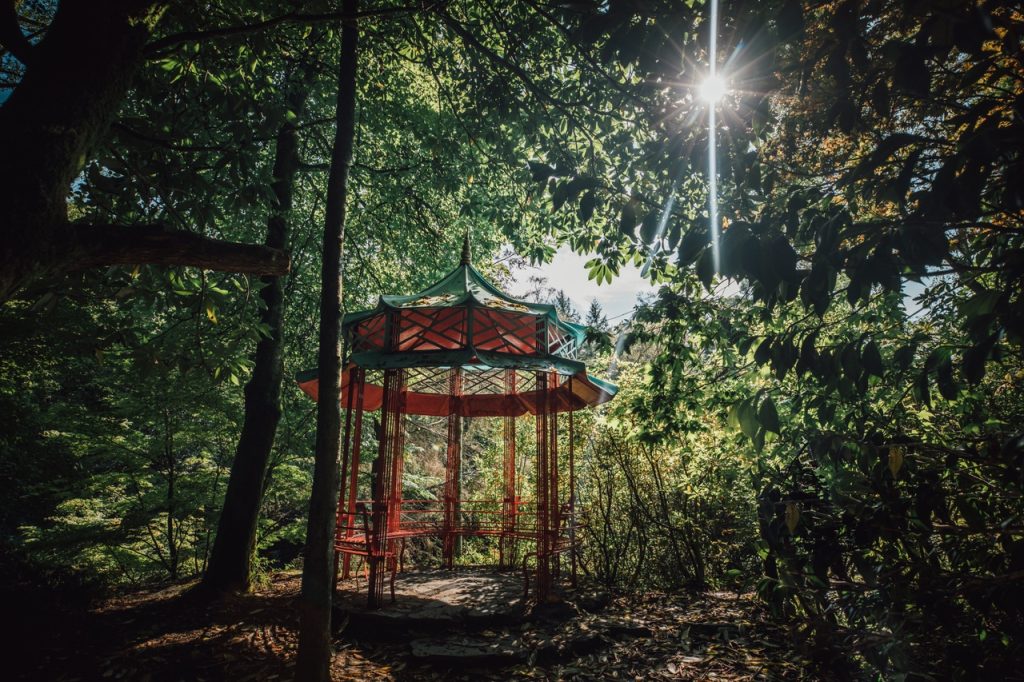Portmeirion

SITUATED on a private peninsula overlooking stunning coastal scenery, the Italian Riviera meets rural Wales with a riot of colour and architectural styles at Portmeirion Village.
Built by Sir Clough Williams-Ellis, Portmeirion is one of Wales’s most popular tourist destinations. A private village resort and gardens, it is set on its own peninsula next to the Dwyryd Estuary on the coast of Snowdonia, open all year round for day visits.
Portmeirion Village is well known as the location for the 1960s cult TV series The Prisoner. It comprises a cluster of colour-washed buildings around a central piazza, scenic surroundings and extensive woodlands, two hotels, historic cottages, gift shops, spa and award-winning restaurants.
In addition, visitors will find an information centre, an audio-visual presentation and a resident artist’s gallery. Free guided tours are available from the information centre near the entrance, during peak season.
The concept of a tightly grouped coastal village had been envisaged by Williams-Ellis years before he found the site, close to his own home in north Wales, on which he managed to realise his dream. Portmeirion has become known as one of the most successful British architectural projects of the 20th Century.
When Williams-Ellis acquired the land in 1925 he wrote: “…a neglected wilderness – long abandoned by those romantics who had realised the unique appeal and possibilities of this favoured promontory but who had been carried away by their grandiose landscaping…into sorrowful bankruptcy.”

Williams-Ellis immediately changed the name from Aber Iâ (Glacial Estuary) to Portmeirion; Port because of the coastal location and Meirion as this is Welsh for Merioneth, the county in which it lay.
His first job was to extend and convert the old house on the shore into a grand hotel.
The Hotel Portmeirion officially opened for the Easter Weekend, on April 2, 1926. The last building, the Tollgate, was built in Williams-Ellis’s 93rd year.
The first article about Portmeirion appeared in The Architects’ Journal (January 6, 1926) with photographs of scale models and preliminary designs prepared by Clough to impress potential investors. In this article, John Rothenstein writes: “On the sea-coast of north Wales, quite near his own old home, Plas Brondanw, he has acquired what he believes to be an ideal site, and he is engaged upon plans and models for the laying out of an entire small township. The results of his scheme will be significant and should do much to shake the current notion that although houses must be designed with due care, towns may grow up by chance.”
Using an eco-friendly approach, Williams-Ellis designed his architectural vision around a Mediterranean piazza. Endangered buildings and unwanted artefacts from all over the globe were transported and rebuilt to create a nest of loggias, grand porticoes and tiny terracotta-roofed houses, painted in bright colours.
The village was built over two phases, 1926-1939 and 1954-1976 by which time Williams-Ellis was well into his 90s. Most buildings were designed and built by Williams-Ellis, but a few were transported from elsewhere such as the Town Hall, the Bristol Colonnade and the facade of the Dome, originally the upper part of a Norman Shaw fireplace.
There is an impressive natural landscape surrounding Portmeirion. The sub-tropical forest, affectionately known as The Gwyllt [Wildwood in Welsh] features some of Britain’s largest trees, secret gardens, a derelict castle and rare flowers. Visitors are able to explore 70 acres of exotic woodlands with 19 miles of pathways which cut through forests, secret spaces and coastal coves.

Also, visitors can discover the exotic Japanese Garden with its pagoda and lily-covered lake and uncover secret sites like the Dog Cemetery, Tangle Wood, Ghost Garden and Shelter Valley.
Many of the unusual species found here pre-date Clough Williams-Ellis. During the Victorian period. former tenants Henry Seymour Westmacott and later Sir Williams Fothergill Cook, a celebrated botanist, planted a mixture of monkey puzzle trees, pines, magnolias, camellias, giant redwoods as well as various rhododendrons on the estate.
By the turn of the 20th Century, Caton Haig, a world authority on Himalayan flowering trees, continued Cook’s works of planting rare species in the woods, including a now-famous selection of rhododendrons.
Among the 70 varieties of rhododendron, are the red-flowering Portmeirion-bred cultivar, known as the ‘Gwyllt King’. Cook also planted a magnificent magnolia campbellii with its enormous pink flowers and several ginkgo bilobas.
Castell Deudraeth has a carefully restored walled Victorian garden with lawns, flowerbeds and flowering trees.
Nearby are the white sandy beaches of the Dwyryd Estruary containing hidden caves, gullies and a flurry of interesting plants.

No visit to Portmeirion Village would be complete without making it down to see the Amis Reunis, or ‘Friends Reunited’, the famous ‘Stone Boat’ of Portmeirion.
Almost as soon as Portmeirion Village opened in 1926, Williams-Ellis bought and converted an old Porthmadog trading ketch which he moored alongside the quay – the Amis Reunis. The Amis was used as a houseboat until she was stranded on a shoal near the Ynys Gifftan. Her remains can still be seen off the coast of Portmeirion during low tide.
Williams-Ellis, having failed to bring her back to shore to repair, decided to salvage what he could and used sections of her mainmast as pillars supporting the dining room’s flat roof. He later decided he would build a stone boat on the coastline of The Hotel Portmeirion in homage to the original Amis Reunis.
(sources include portmeirion.wales, tripadvisor)
Back to HOME PAGE
